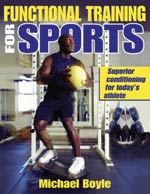| Ron Jones Bio |
| CorporateWellness |
| Coach & Train |
| Exercise Library |
| Handouts |
| Health & Fitness |
| KETTLEBELLS |
| Products by RJ |
| Site Map |
"Functional Training for Sports"
By Mike Boyle
Multi-Planar Training, Acceleration/Deceleration
About the author:
Mike Boyle is regarded as a leader in the field of strength and conditioning.
Before his work with Athletes' Performance, Boyle was owner of Mike Boyle
Strength and Conditioning, which emphasized performance enhancement and injury
prevention to provide athletes of all ages.
Before opening his business, Boyle spent 17 years as the strength and conditioning coach at Boston University and 10 years as the strength and conditioning coach for the NHL's Boston Bruins. He was one of the first strength and conditioning coaches to prepare athletes specifically for the NFL Combine, a trend that is now industry-wide. He also was the strength and conditioning coach for the 1998 gold medal-winning U.S. women's Olympic ice hockey team.
Widely known for his work with hockey players, Boyle also has trained athletes in many of the major professional sports leagues in North America, including the NHL, NFL, NBA, MLB, MLS, and WNBA. Boyle lives in Reading, Massachusetts, with his wife, Cynthia.
From Chapter 12: Performance Enhancement Programs
FUNCTIONAL TRAINING FOR SPORTS, by Michael Boyle ($13.96 + Shipping)
changing. Coaches and trainers have made huge advances in
their understanding of the physiology of sports and in
designing programs that stress the appropriate energy
systems. Although many programs now use work-to-rest ratios
that are much more appropriate for team sports, few programs
address changes of direction as a vital component of sport
conditioning. The areas of conditioning that now need to be
developed are muscular specificity and movement specificity.
All the programs detailed in this chapter address changes of
direction as a key component of conditioning. The ability to
tolerate the muscular forces generated by accelerating and
decelerating and the ability to adapt to the additional
metabolic stress caused by acceleration and deceleration are
the real keys to conditioning. Deficiencies in these components
are often why athletes describe themselves as not being in
“game shape.” Most athletes have trained by running, or worse,
riding a set distance in a set amount of time with no thought
to the additional stresses provided by having to speed up and
slow down. Athletes frequently are injured in training camp
settings in spite of following a prescribed conditioning
program to the letter. This is usually due to following a
conditioning program that ignores the vital components of the
conditioning process:
2. Deceleration
3. Change of direction
and change direction drastically reduce the incidence of early-
season groin and hamstring injuries and better prepare the
athletes for the demands of an actual game or event.
characteristics:
Conditioning programs should not be designed to allow the
athlete to pass an arbitrary conditioning test but to prepare
the athlete to participate in the sport itself.
of direction. Injuries most often occur in acceleration and
deceleration. Often athletes are injured not because they are
out of shape but because they are poorly prepared. One minute
of straight-ahead running on a track and one minute of stop-
and-start shuttle running are drastically different, both
muscularly and metabolically.
sprint. That is, the stride pattern must be similar to sprinting.
To condition the hip flexors and hamstrings (the muscles most
often injured in preseason), the athlete must aggressively
extend and recover the hip. Consider that a six-minute mile is
run at the speed of an eight-second 40-yard dash. No wonder many
athletes who think they are prepared often injure themselves.
movement days, conditioning has a lateral movement emphasis. This
means that two days per week, conditioning is done on the slide
board, regardless of the sport.
copy today!
Michael Boyle
Paperback • 208 Pages
ISBN 0-7360-4681-X ($13.96 + Shipping)
RonJones.Org | Back to Health & Fitness | Site Map
(Updated 11.24.10)

